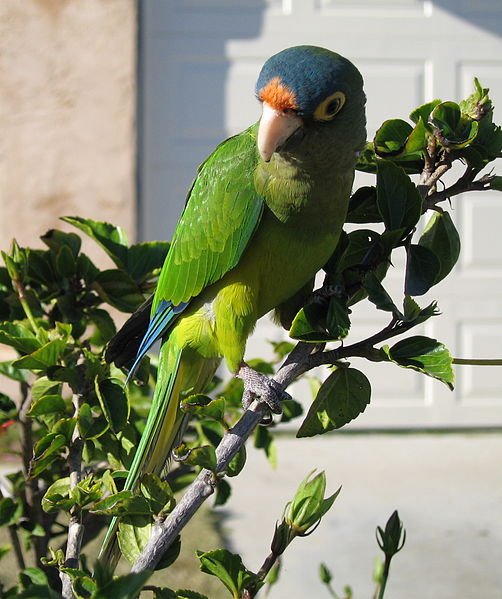 Last time we took a look at the unusual nesting behavior of this popular little parrot (please see The Half Moon, Orange-Fronted or Petz’s Conure and its Relationship with the Arboreal Black-Headed Termite.) But, as if breeding in termite mounds were not enough to distinguish it from other parrots, the half moon conure also changes the usual parrot “roosting rules” as well. And with good reason…
Last time we took a look at the unusual nesting behavior of this popular little parrot (please see The Half Moon, Orange-Fronted or Petz’s Conure and its Relationship with the Arboreal Black-Headed Termite.) But, as if breeding in termite mounds were not enough to distinguish it from other parrots, the half moon conure also changes the usual parrot “roosting rules” as well. And with good reason…
Giant Bats and Conures…Avoiding a Nightmarish Predator
The half moon conure exhibits a few odd behaviors as regards predator avoidance. Researchers in Guancastle, Costa Rica, have noted that resident half moon conures change roosting sites nightly. It seems that they are the favored prey of a truly unique predator, the huge false vampire bat, Vampyrum spectrum (I’d certainly move around allot if it helped to outwit a giant, flesh-eating bat!).
False vampires are spectacular and unusual bats. Although I have yet to see one in the wild, I was shown a roosting hollow in Costa Rica (they roost singly or in small groups, unlike most bats). The floor below the tree cavity in which the beast spent the day was littered with parrot feathers and the skulls of rodents, frogs and other bats.
A Quiet Group of Parrots?
Another unusual half moon trait is their habit of becoming very quiet upon first sighting a predator. The quiet – rather than, as with most parrots, the noise – spreads to adjacent groups of conures very quickly. If the predator advances, the conures begin to scream in true parrot fashion and fly off.
Further Reading
A false vampire bat may have been an incident involving a parrot that I came to know while working in Costa Rica. Please see my article Parrots and the Perils of the Tropical Night.
The following article contains a wealth of information on false vampire bats in the wild and captivity. Bats are not birds…but this one is well-worth reading about!
http://www.science.smith.edu/departments/Biology/VHAYSSEN/msi/pdf/i0076-3519-184-01-0001.pdf
Photo courtesy of Wikipedia Commons.
 That Bird Blog – Bird Care and History for Pet Birds
That Bird Blog – Bird Care and History for Pet Birds




I appreciate your informative bird blog.
As a new reader, I would like to touch upon a couple of points.
First off, with regard to their behavior in the wild, has anyone posted pictures of a Half Moon Conure nesting site among the termite mounds on this blog or anywhere else on the internet that you’re aware of?
Secondly, I’ve heard that Half Moon conures are endangered in the wild. Is this true?
Next, I would like to relay that these birds can be fantastic talkers. Mine knew how to use about 60 vocabulary words and because he used them in appropriate contexts, it seemed to contradict the notion that birds of this kind are merely mimics. He learned entire phrases that he could string together in primitive statements, much along the lines of a 2-year-old child.
Unfortunately, my final comment is on the health of the Half Moon conures, and related species. Apparently, these birds are prone to a threat of an entirely different variety — a bleeding disorder thought to be caused by a virus and/or a nutritional imbalance (the latter of which may pertain to improper seed or fruit-heavy diets that do not contain adequate calcium and/or vitamin K).
To your knowledge, is Conure Bleeding Syndrome (CBS) mainly a captive conure disease? Are there documented cases of wild conures succumbing to this tragic affliction?
Thank you.
Hello Lynn, Frank Indiviglio here.
Thanks so much for the interesting post and kind words, much appreciated.
Please click here for a photo of a nest within an arboreal termite mound.
They have a wide range, and have not been properly studied, so its difficult to access their status. As of now, they are not considered to be in danger; the IUCN lists them as “Least Concern”, but again this is not based on thorough surveys.
Thanks for the report on your bird’s abilities; I am hearing of more and more examples of parrots that are accurately associating words and objects/ actions. Your bird may hold the species vocabulary record!
Thanks for the note on Conure Bleeding Disorder; I find no references of its occurrence in wild birds, but I doubt anyone has looked closely; I’ve done a quick search of the Journal of Avian Medicine and Surgery as well, just in case. If a virus is involved, then it could possibly occur in wild birds; if nutritional/stress related, it may be limited to captives. I’ll keep an eye out for you – please also send along any new info you may come across.
Please let me know if you need any further information. Good luck, enjoy and please keep me posted…I look forward to hearing from you in the future.
Best regards, Frank Indiviglio.